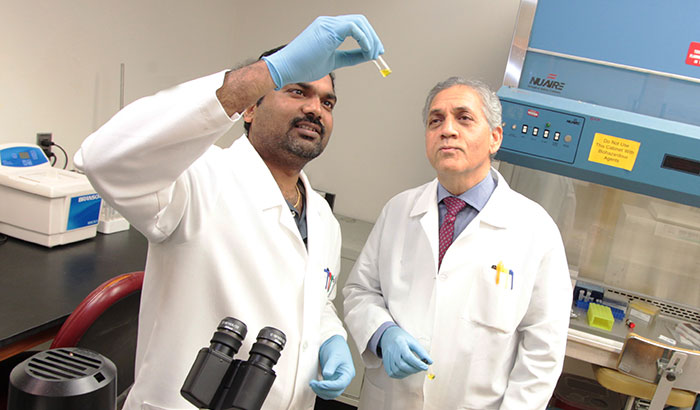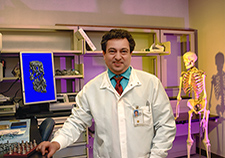Office of Research & Development |
 |


Drs. Rakesh Meka (left) and Kamal Moudgil and their team at the Baltimore VA Medical Center and University of Maryland are developing a targeted drug therapy to treat painful joints without affecting other tissues. (Photo by Mitch Mirkin)
June 3, 2019
By Tristan Horrom
VA Research Communications
"This research is a fine example of how nanotechnology-based targeted drug delivery can lead to more effective and safe treatment of a painful and debilitating disease like arthritis."
Baltimore VA Medical Center researchers have developed a technique to deliver arthritis medication primarily to the joints. By encasing medication in a molecular structure that homes in on inflamed joints, the new technique gets the drugs where they need to go without affecting the rest of the body.
The medication can be injected into the bloodstream, and is then directed to inflamed joints. When given to rats, the therapy was more effective at stopping arthritis than other modes of treatment with the same medication.
“This research is a fine example of how nanotechnology-based targeted drug delivery can lead to more effective and safe treatment of a painful and debilitating disease like arthritis,” said Dr. Kamal Moudgil, corresponding author on the paper. Moudgil is a researcher at the Baltimore VA Medical Center and professor of microbiology and immunology at the University of Maryland School of Medicine.
The results online April 2, 2019, in Nanomedicine.

Pain reduction, via positive psychology and the Web

Study: More pain relief with new knee replacement method

Boning up: Lab tests show promise for bone-regenerating injection
Rheumatoid arthritis is a debilitating autoimmune disease involving chronic inflammation of the joints. It can lead to joint damage and deformity. Rheumatoid arthritis affects about 1.3 million Americans.
The usual treatment involves disease-modifying antirheumatic drugs. While these drugs—taken either orally or by injection—help with arthritis, they can cause problems in other parts of the body. Following oral intake or injection, these drugs spread widely in the entire body, and some tissues besides the joints absorb them. Over the long-term, this can cause serious side effects, such as liver and kidney damage.
One common rheumatoid arthritis drug, dexamethasone (sold as Decadron, DexPak, and other names), can cause problems with the gastrointestinal, cardiovascular, musculoskeletal, and metabolic systems. Conditions such as hypertension, osteoporosis, and diabetes have been linked to the drug.
To address the side-effect problem, the researchers developed a targeted therapy. They encased dexamethasone in a liposome—a spherical molecular structure made mostly of lipids (fats). The liposome was in turn coated in another molecular substance made of amino acids that the researchers named ART-2. ART-2 is drawn to inflamed joints when injected into the bloodstream, meaning the liposome carries the drug to the joints and avoids other organs.
The new targeted drug approach appears to curb dangerous side effects. Rats given the ART-2 therapy showed significantly less toxic effect from the drug than with other delivery methods.
The new treatment technique also showed improvements in arthritis relief. The researchers injected rats that had a condition similar to rheumatoid arthritis with one of three approaches: free dexamethasone; the drug encapsulated in standard liposomes; or liposomes coated with ART-2. The ART-2-guided delivery was much more effective at treating arthritis than the other two methods, based on an analysis of swelling in the rats’ paws.
Targeted drug therapy is being studied for other conditions as well. Most of the research focuses on cancer, but it is also being studied for use with autoimmune diseases besides rheumatoid arthritis, such as lupus. According to the researchers, targeted drug delivery such as they’ve demonstrated has great potential for treating autoimmune diseases. In their words, “the future appears bright for this growing field.”
VA Research Currents archives || Sign up for VA Research updates